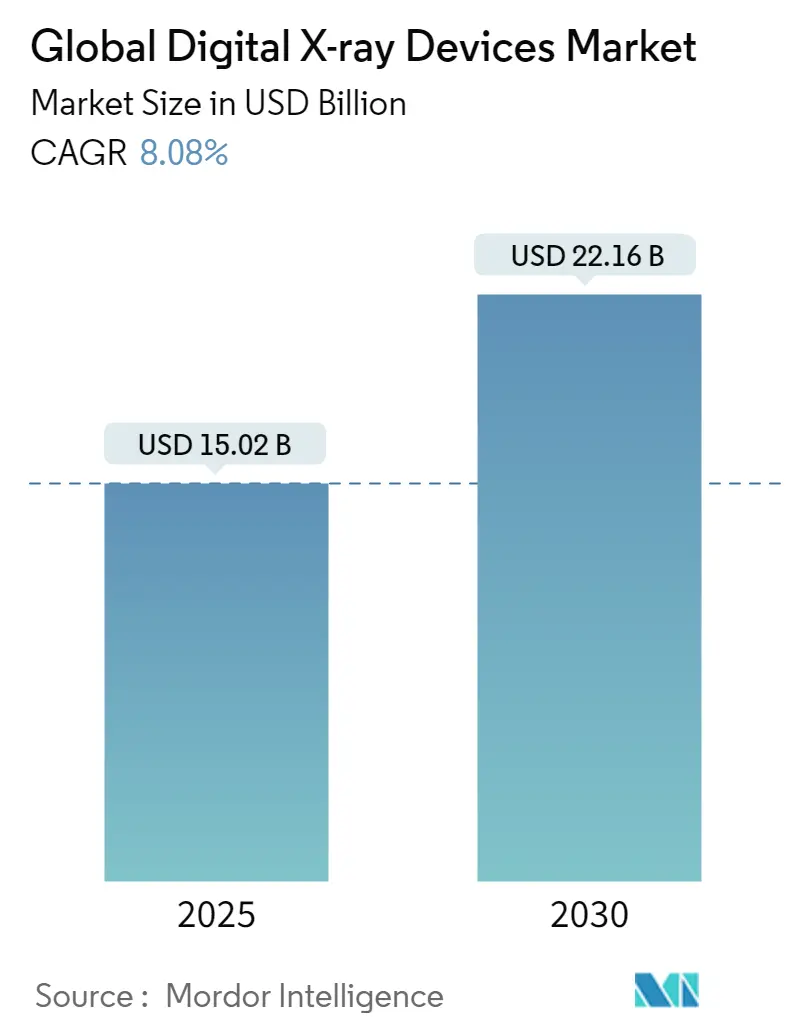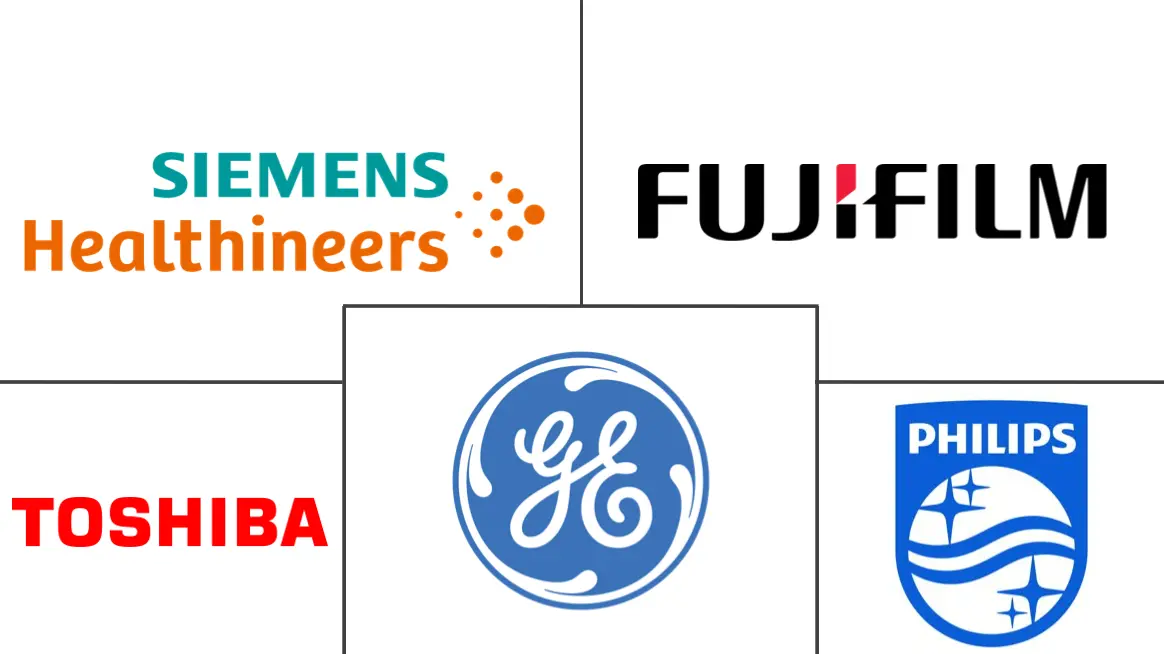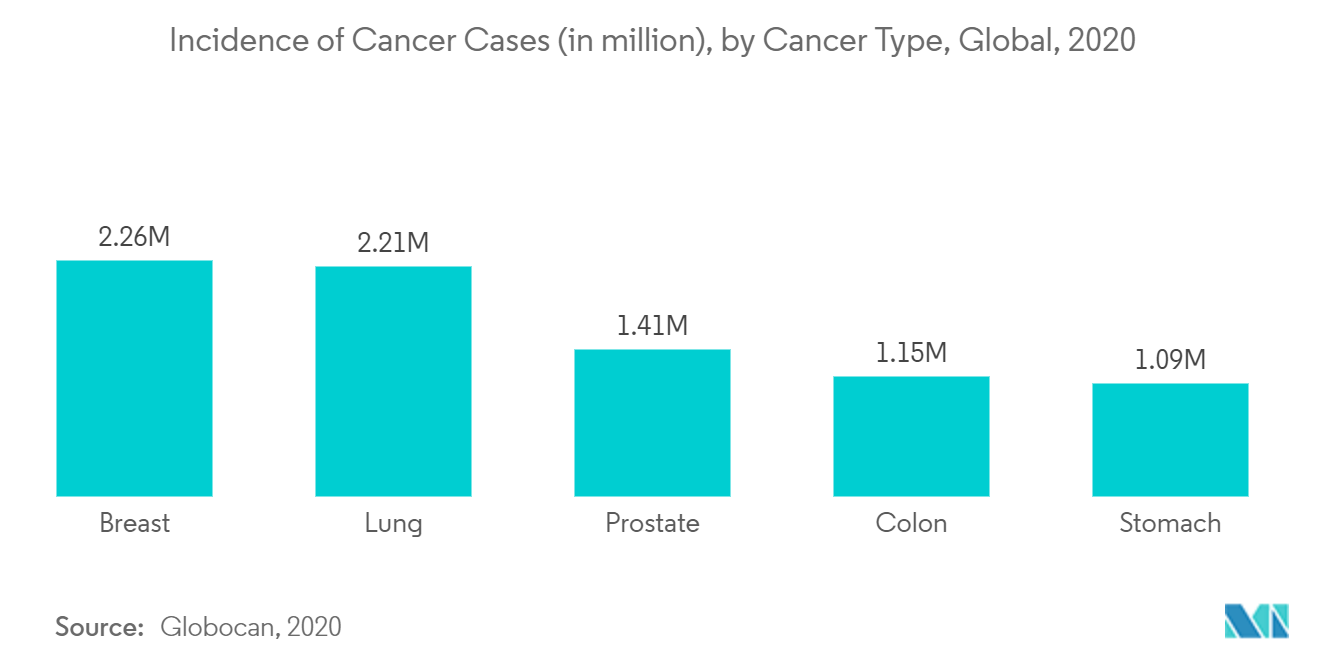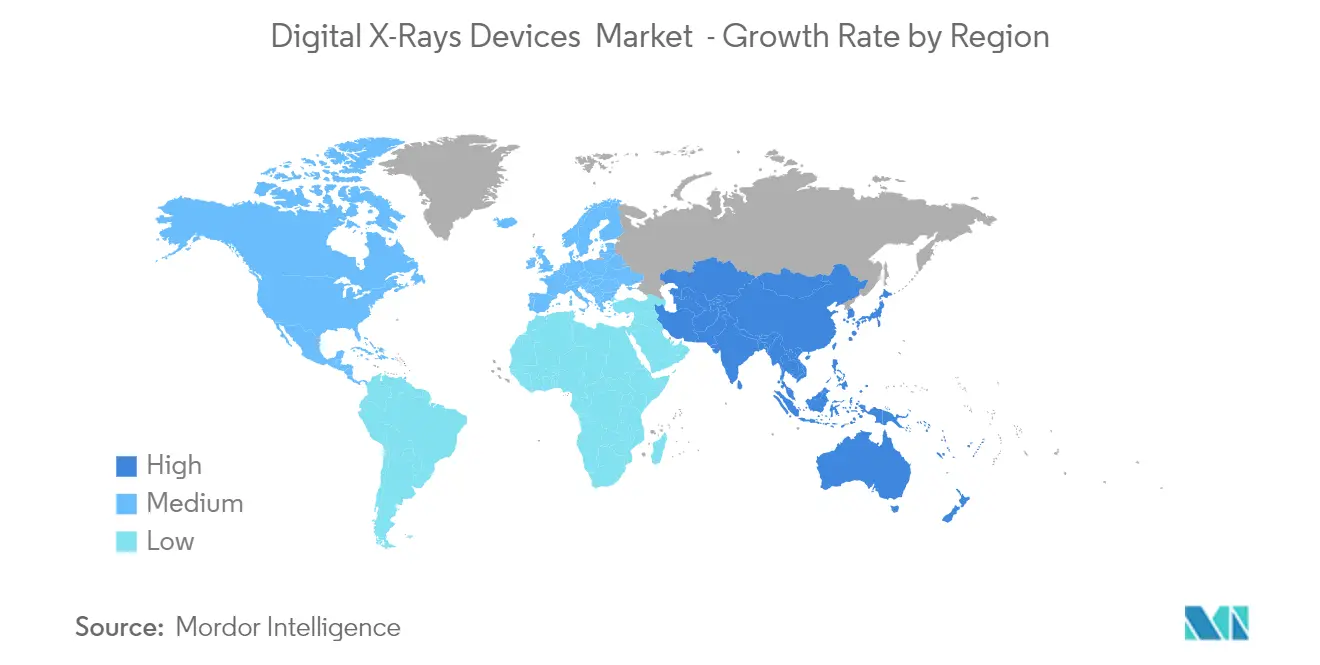
| Study Period | 2019 - 2030 |
| Market Size (2025) | USD 15.02 Billion |
| Market Size (2030) | USD 22.16 Billion |
| CAGR (2025 - 2030) | 8.08 % |
| Fastest Growing Market | Asia Pacific |
| Largest Market | North America |
| Market Concentration | High |
Major Players
*Disclaimer: Major Players sorted in no particular order |
Digital X-ray Devices Market Analysis
The Global Digital X-ray Devices Market size is estimated at USD 15.02 billion in 2025, and is expected to reach USD 22.16 billion by 2030, at a CAGR of 8.08% during the forecast period (2025-2030).
The COVID-19 pandemic has turned the spotlight on diagnostic imaging, particularly on digital X-ray devices. Digital imaging plays a key role in the diagnosis of COVID-19 and indicates the affected lung tissue in infected patients. Several key market players had focused on innovations in the production of radiography equipment. For instance, in December 2020, Agfa HealthCare launched its new SmartXR for X-ray Artificial Intelligence (AI) for Digital Radiography portfolio to aid during the radiology routine, which has proven important during the COVID-19 crisis. Thus, during the pandemic, the digital X-rays devices market is expected to be positively impacted by COVID-19 accurate diagnosis and treatment.
The studied market growth can largely be attributed to factors, such as the increasing occurrence of orthopedic diseases and cancers, the increasing number of serious injuries, the advantages of digital X-ray systems over conventional X-rays, technological advancements, and product development. Digital X-ray devices use digital x-ray sensors instead of films to capture images. This results in an immediate preview of the images that ultimately improves time efficiency and capacity to digitally transfer images.
The major advantages of digital imaging are cost-effectiveness and easy accessibility. The hospitals can manage the cost-cutting by lowering the film price, reducing the requirement of storage space, and decreasing the number of people required to run the services and archive sections. The images are also instantly available for distribution to the clinical services without the time and physical effort needed to retrieve film packets and reviewing previous imaging on a patient is much easier. This factor majorly impacts the growth of the digital X-ray devices market. Digital X-rays expose approximately 70-80% less radiation than conventional X-rays. This is hugely beneficial for the long-term health of patients, especially pregnant women or patients who are already suffering from illness, thus ensuring safety. With the help of digital X-rays, dentists can now easily recognize oral issues, which is leading to a declining need for an invasive investigation at the diagnosis stage. Additionally, digital radiography safely stores patient X-rays, resulting in no loss from the holders.
Also, due to the increase in the number of dental disorders, cardiac disorders, cancers especially breast cancer, there is an increased demand for digital X-ray devices globally. The American Heart Association (AHA), Heart Disease and Stroke Statistics - 2022 Update data shows that cardiovascular disease (CVD) is listed as the primary underlying cause of death accounting for 19.05 million deaths all over the world in the year 2020. As per the same source, around 7.08 million deaths worldwide were attributed to cerebrovascular diseases in the year 2020. Such a high prevalence of cardiac disease among the population in the country reaped the demand for imaging devices with precise diagnosis and hence Digital X-ray devices acquire their importance in this context.
Additionally, the advancements in technology and increasing product approvals, along with partnerships and collaborations by key players are helping in the market growth. For instance, in February 2022, Carestream Health India has announced the launch of the DRX Compass, an accurate, convenient and configurable digital radiation solution that provides radiologists with a whole new level of efficiency. In addition, DRX Compass provides versatility for configuring desired configurations from a wide range of detectors, tubes, generators, stages and collimators, and how radiation facilities deploy this futuristic digital radiation technology.
Thus, all the aforementioned factors are currently augmenting the growth of the digital X-ray devices market. However, the high installations and device cost, along with the rise in the use of refurbished devices are likely to hinder the market growth.
Digital X-ray Devices Market Trends
Portable Systems Segment is Expected to Dominate the Market Over the Forecast Period
The major factors driving the growth of portable systems include advanced technology, a rising number of patients with chronic diseases, an increasing geriatric population, and rising awareness regarding the availability of portable systems. Additionally, the portable X-ray machine has the potential to overcome location barriers and benefit patients who are in life-threatening situations and require immediate treatment wherever they are, possibly needing an on-the-spot diagnosis.
Thus, portable X-ray devices play a vital role in the diagnosis and monitoring of the patient's bedside, with no hurdle of transfer of the patient to the X-ray room. The portable X-ray systems offer several advantages over the traditional X-ray systems. For instance, according to the American College of Radiology (ACR) recommendations published in March 2020, the CT decontamination required after scanning COVID-19 patients may disrupt radiological service availability and has suggested that portable chest radiography may be considered to minimize the risk of cross-infection during the pandemic.
The increasing product launches related to portable X-ray devices surge the growth of the studied market. For instance, in August 2020, Canon Medical USA launched the SOLTUS 500 Mobile Digital X-ray system that is equipped with enhancements that can streamline bedside exams to help improve workflow and productivity. Again, in March 2021, Fujifilm India Private Limited announced the launch of its mobile digital radiology system - FDR nano which is around 80% lighter in weight as compared to traditional mobile X-rays.
Also, in July 2022, Shimadzu Corporation announced the addition of the new MobileDaRt Evolution MX8 Version v type digital mobile X-ray system to the mobile X-ray system lineup, for release outside Japan. The system incorporates digital radiography (DR), which is in demand outside Japan.
Thus, given the advantages of portable systems and increasing product launches, the segment is expected to grow significantly over the forecast period.

North America has been Dominant in the Digital X-Ray Devices Market and Similar is Expected Over the Forecast Period.
Within North America, the United States holds the major market share for the studied market and is expected to dominate over the forecast period. The increasing adoption of healthcare systems towards sophisticated technology and the growing burden of chronic diseases such as cancer, and diabetes, in the region are the major factors driving the digital X-Rays devices market in North America. The GLOBOCON 2020 data shows that in 2020 the new cancer cases diagnosed were 2,281,658 in the United States, with 612,390 deaths.
Further, as per the Arthritis Foundation Fact sheet 2019, the number of adults in the United States with doctor-diagnosed arthritis is projected to reach 78.4 million by 2040. Also, according to Arthritis Foundation data updated in October 2021, 1.5 million people in the United States have rheumatoid arthritis, where arthritis most commonly begins between ages 30 and 60 in women. The high incidence of these chronic diseases surges the demand for accurate diagnosis and plans of efficient and on-time treatment by the healthcare provider. Hence, drives the growth of the studied market in North America.
Additionally, the high concentration of key players, along with the increasing product approvals and launches is expected to drive the studied market. For instance, in December 2020, Canon Medical System USA, Inc., launched the OMNERA 500A Digital Radiography system with an advanced intelligent auto-positioning feature to improve the workflow. Also, in April 2022, Samsung introduced the GM85 Fit, a new configuration of the premium AccE GM85, a digital radiography device featuring a user-centric design that aids in efficient and effective patient care. The GM85 Fit recently received 510(k) clearance from the United States Food and Drug Administration for commercial use in the United States.
Thus, given the above-mentioned factors, the digital X-ray devices market is anticipated to grow significantly over the forecast period in North America.

Digital X-ray Devices Industry Overview
The digital X-ray devices market is nearly consolidated and moderately competitive as per the competitive analysis owing to the few companies that are currently dominating the market. These companies include GE Healthcare, Koninklijke Philips NV, Fujifilm Holdings Corporation, Siemens Healthineers, and Canon Medical System Corporation (Toshiba Corporation) among others. The competition in the market is majorly based on technological advances and the pricing of digital X-ray equipment. Additionally, the key players have been involved in various strategic alliances such as acquisitions, collaborations along with launch of advanced products to secure the position in the global market.
Digital X-ray Devices Market Leaders
-
Canon Medical Systems Corporation(Toshiba Corporation)
-
GE Healthcare
-
Koninklijke Philips NV
-
Fujifilm Holdings Corporation
-
Siemens Healthineers
- *Disclaimer: Major Players sorted in no particular order

Digital X-ray Devices Market News
- In July 2022, Fujifilm announced the United States launch of the FDR Cross, an innovative hybrid c-arm and portable X-ray solution built for hospitals and ambulatory surgery centers (ASC). The dual-function c-arm is the first of its kind to offer portable fluoroscopic and radiographic imaging on a single platform, reducing the need to bring in additional imaging equipment for essential image-guided procedures.
- In March 2022, Konica Minolta, Inc. launched AeroDR TX m01, a mobile X-ray system featuring a wireless dynamic digital radiography function in Japan.
Digital X-ray Devices Industry Segmentation
As per the scope of this report, digital X-ray or digital radiography is a form of X-ray imaging where digital X-ray sensors are used instead of traditional photographic films. This has an added advantage of time efficiency and the ability to transfer images digitally, as well as enhance them for better visibility. This method bypasses the chemical processing of photographic films. Digital X-ray imaging has high demand, as it requires less radiation exposure compared to traditional X-rays. The Digital X-ray Devices Market is Segmented by Application (Orthopedic, Cancer, Dental, Cardiovascular, and other applications), Technology (Computed Radiography and Direct Radiography), Portability (Fixed Systems, and Portable Systems), End-User (Hospitals, Diagnostic Centers, Other End Users), and Geography (North America, Europe, Asia-Pacific, Middle East & Africa, and South America). The market report also covers the estimated market sizes and trends for 17 different countries across major regions, globally. The report offers the value (in USD million) for the above segments.
| By Application | Orthopedic | ||
| Cancer | |||
| Dental | |||
| Cardiovascular | |||
| Other Applications | |||
| By Technology | Computed Radiography | ||
| Direct Radiography | |||
| By Portability | Fixed Systems | ||
| Portable Systems | |||
| By End User | Hospitals | ||
| Diagnostic Centers | |||
| Other End Users | |||
| Geography | North America | United States | |
| Canada | |||
| Mexico | |||
| Europe | Germany | ||
| United Kingdom | |||
| France | |||
| Italy | |||
| Spain | |||
| Rest of Europe | |||
| Asia-Pacific | China | ||
| Japan | |||
| India | |||
| Australia | |||
| South Korea | |||
| Rest of Asia-Pacific | |||
| Middle East and Africa | GCC | ||
| South Africa | |||
| Rest of Middle East and Africa | |||
| South America | Brazil | ||
| Argentina | |||
| Rest of South America | |||
Digital X-ray Devices Market Research FAQs
How big is the Global Digital X-ray Devices Market?
The Global Digital X-ray Devices Market size is expected to reach USD 15.02 billion in 2025 and grow at a CAGR of 8.08% to reach USD 22.16 billion by 2030.
What is the current Global Digital X-ray Devices Market size?
In 2025, the Global Digital X-ray Devices Market size is expected to reach USD 15.02 billion.
Who are the key players in Global Digital X-ray Devices Market?
Canon Medical Systems Corporation(Toshiba Corporation), GE Healthcare, Koninklijke Philips NV, Fujifilm Holdings Corporation and Siemens Healthineers are the major companies operating in the Global Digital X-ray Devices Market.
Which is the fastest growing region in Global Digital X-ray Devices Market?
Asia Pacific is estimated to grow at the highest CAGR over the forecast period (2025-2030).
Which region has the biggest share in Global Digital X-ray Devices Market?
In 2025, the North America accounts for the largest market share in Global Digital X-ray Devices Market.
What years does this Global Digital X-ray Devices Market cover, and what was the market size in 2024?
In 2024, the Global Digital X-ray Devices Market size was estimated at USD 13.81 billion. The report covers the Global Digital X-ray Devices Market historical market size for years: 2019, 2020, 2021, 2022, 2023 and 2024. The report also forecasts the Global Digital X-ray Devices Market size for years: 2025, 2026, 2027, 2028, 2029 and 2030.
Our Best Selling Reports
Digital X-ray Devices Industry Report
Statistics for the 2025 Global Digital X-ray Devices market share, size and revenue growth rate, created by Mordor Intelligence™ Industry Reports. Global Digital X-ray Devices analysis includes a market forecast outlook for 2025 to 2030 and historical overview. Get a sample of this industry analysis as a free report PDF download.




